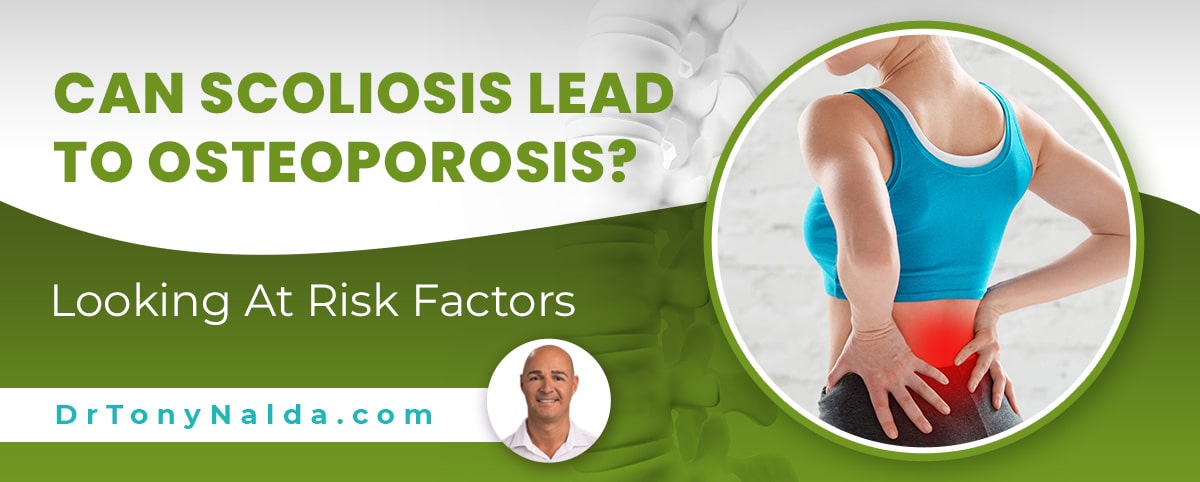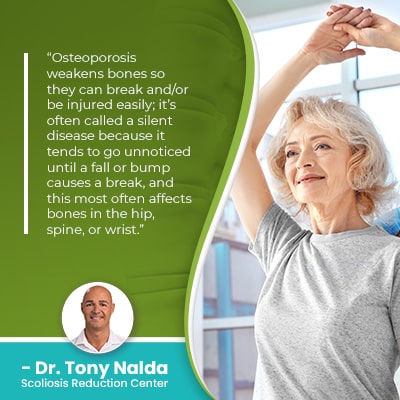Can Scoliosis Lead To Osteoporosis? Looking At Risk Factors

Idiopathic scoliosis is thought to be multifactorial, meaning caused by a number of variables, and when we’re talking about the connection between scoliosis and osteoporosis, as osteoporosis tends to affect older adults, a link between scoliosis and degenerative scoliosis, that also affects adults as they age, is the most likely.
Whether or not scoliosis can lead to osteoporosis is still being explored. While there does appear to be a link between idiopathic scoliosis and low bone mass, it’s more of a contributing factor; a link between osteoporosis and degenerative scoliosis more likely but also remains unclear.
Let’s start our exploration of the link between osteoporosis and scoliosis by first defining each condition.
Table of Contents
What is Scoliosis?
Scoliosis is a highly-prevalent spinal condition that involves the development of an unnatural lateral (sideways) spinal curvature that also rotates, meaning the spine twists unnaturally, making it a complex 3-dimensional condition.
Scoliosis is also progressive, meaning its nature is to get worse over time, and as scoliosis progresses, the spine is getting increasingly rigid, making it less responsive to treatment.
Scoliosis introduces a lot of uneven forces to the body, and with progression, those uneven forces increase, as do their effects.
When it comes to treating scoliosis, it’s far simpler to proactively work towards preventing progression and increasing effects than it is to work towards reversing them once they’ve developed.
The more severe a condition is, the more likely it is to continue progressing, and while scoliosis is an incurable progressive spinal condition, it can be highly treatable, especially when early detection is responded to with a proactive treatment plan.
There are also different severity levels of scoliosis ranging from mild to moderate and severe to very severe, and in addition, there are also multiple types of scoliosis a person can develop.
The most common type of scoliosis to affect both children and adults is idiopathic scoliosis, and idiopathic means we don’t fully understand why the condition develops initially, but we do know what triggers it to progress: growth and development.
Idiopathic scoliosis accounts for approximately 80 percent of known diagnosed scoliosis cases, and the remaining 20 percent are associated with known causes: neuromuscular scoliosis, degenerative scoliosis, and congenital scoliosis.
So as you can see, in the vast majority of scoliosis cases, we don’t know what triggers their initial onset, and as the Scoliosis Research Society has current estimates at close to seven million people living with scoliosis in the United States alone, it is a highly-prevalent spinal condition; its prevalence explains the many theories that attempt to explain the etiology of idiopathic scoliosis.
In the context of osteoporosis, degenerative scoliosis is the condition-type with the likeliest connection, which we’ll return to later.
What is Osteoporosis?
Bones are a type of living tissue with their own vascular supply; they are made from a combination of cells, minerals, vitamins, and proteins.
Bones are constantly growing, transforming, and repairing themselves, and osteoporosis develops when bone is breaking down faster than it can be replaced.
The internal structure of bone resembles a honeycomb, and the bone is the honeycomb’s outer layer; osteoporosis makes the bone get smaller, and this increases the spaces between the bone, causing its outer shell to become excessively thin and frail.
 Osteoporosis weakens bones so they can break and/or be injured easily; it’s often called a silent disease because it tends to go unnoticed until a fall causes a break, and this most often affects bones in the hip, spine, or wrist.
Osteoporosis weakens bones so they can break and/or be injured easily; it’s often called a silent disease because it tends to go unnoticed until a fall causes a break, and this most often affects bones in the hip, spine, or wrist.
When osteoporosis is severe, small movements such as coughs or bumps can cause a bone fracture.
Osteoporosis most commonly affects adults over the age of 50, and when we’re talking about the different types of scoliosis, degenerative scoliosis, as mentioned, also tends to affect the same age group, so let’s now explore the potential connection between degenerative scoliosis and osteoporosis.
Degenerative Scoliosis and Osteoporosis
As mentioned, there are multiple types of scoliosis, and the one with the closest potential link to osteoporosis is degenerative scoliosis as both conditions affect adults over the age of 50 and involve bone instability.
Degenerative scoliosis is caused by natural age-related spinal degeneration and is more commonly diagnosed in females than in males, and this is understood as the result of bone density and hormone changes caused by menopause; the same can be said of osteoporosis, which is also far more common in females than males.
In most cases of spinal degeneration, it’s the intervertebral discs that are the first spinal structures to feel the effects of deterioration; the discs sit between adjacent vertebrae to provide cushioning, act as the spine’s shock absorbers, give the spine structure (adjacent vertebrae attach to the disc in between), and combine forces to facilitate flexible movement.
So if a disc starts to degenerate, it can become desiccated and lose height, and the change in the position and size of the disc affects adjacent vertebrae and can cause them to shift out of alignment with the rest of the spine, and this leads to the development of an unnatural spinal curve.
While there is a certain amount of spinal degeneration to be expected with age, the cumulative effect of certain lifestyle choices also play a role in the rate and severity of degenerative spinal changes.
Carrying excess weight, leading a sedentary lifestyle, chronic poor posture, excessive consumption of alcohol and/or smoking, and repeatedly lifting heavy objects incorrectly can cause extra strain on the spine, uneven wear and tear, can make it more prone to injury, and more vulnerable to degenerative changes.
So what about degenerative scoliosis and osteoporosis? Can degenerative scoliosis lead to the development of osteoporosis, or vice versa?
Unfortunately, there is no clear and simple answer because a clear causative link has yet to be found between the two conditions; the link might be more indirect as osteoporosis weakens the spine’s vertebrae, so might be more of a risk factor for scoliosis, than an actual cause.
 As osteoporosis can weaken the bones of the spine to the point where they can easily become fractured, the weakened vertebrae can cause the spine to become unstable and disrupt its ability to maintain its natural curves and alignment.
As osteoporosis can weaken the bones of the spine to the point where they can easily become fractured, the weakened vertebrae can cause the spine to become unstable and disrupt its ability to maintain its natural curves and alignment.
So while it might be a stretch to assume that degenerative scoliosis can lead to osteoporosis, it’s possible that osteoporosis could weaken the spine to the point that it’s too unstable to support its natural curves, causing scoliosis to develop as a result.
Basically, any condition that adversely affects the spine’s overall health, function, and structure has the potential to contribute to the development of scoliosis, but that link can be more indirect than direct and isn’t always clear.
Conclusion
While one of the many theories attempting to explain idiopathic scoliosis causation has explored the connection between low bone mass and the onset of adolescent idiopathic scoliosis, that link remains unclear.
While the noted levels of low bone mass in adolescents with scoliosis does suggest that scoliosis could be a condition of bone health, the potential link between osteoporosis and scoliosis also remains unclear.
When it comes to the onset of degenerative scoliosis in adults, osteoporosis is generally regarded more as a risk factor because the condition has the potential to weaken the bones of the spine to the point that the spine’s overall health, strength, and function are disrupted.
When the bones of the spine are weak, it’s that much more difficult for the spine to maintain its natural curves and alignment, and this also makes the spine more vulnerable to a variety of injuries, issues, and conditions.
Scoliosis, on the other hand, is more known to negatively impact the structure of the spine in terms of its rotation and vertebral alignment; it’s not known to actually weaken the structure of the individual vertebral bodies to the point that osteoporosis can.
Therefore, it’s more likely that osteoporosis contributes to the onset of degenerative scoliosis than it is that scoliosis causes osteoporosis.
Here at the Scoliosis Reduction Center, I treat scoliosis with a proactive conservative chiropractic-centered treatment approach that has the potential to impact scoliosis on every level.
As a structural spinal condition, scoliosis has to, first and foremost, be impacted on a structural level, which I work towards through a series of condition-specific chiropractic adjustments that, when successful, can realign the spine.
Through condition-specific physical therapy, the spine’s surrounding muscle-strength can be increased so it’s optimally supported and posture is improved.
Through corrective bracing and rehabilitation, the spine can be pushed into a corrective position, and a series of custom-prescribed exercises can help patients establish a home-rehabilitation program to further stabilize and heal the spine.
Dr. Tony Nalda
DOCTOR OF CHIROPRACTIC
After receiving an undergraduate degree in psychology and his Doctorate of Chiropractic from Life University, Dr. Nalda settled in Celebration, Florida and proceeded to build one of Central Florida’s most successful chiropractic clinics.
His experience with patients suffering from scoliosis, and the confusion and frustration they faced, led him to seek a specialty in scoliosis care. In 2006 he completed his Intensive Care Certification from CLEAR Institute, a leading scoliosis educational and certification center.
About Dr. Tony Nalda
 Ready to explore scoliosis treatment? Contact Us Now
Ready to explore scoliosis treatment? Contact Us Now





